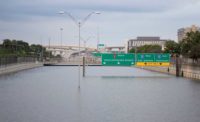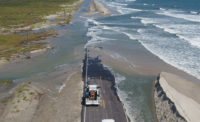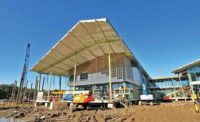On the morning of Nov. 8, flaming pine needles rained down on the homes of Paradise, Calif., blown from the Camp Fire, still 2.5 miles away. The embers set fire to roofs, attics, landscaping, decks and any other fuel in their path.
 Within four hours, most of the town’s homes and buildings were in ashes. Surrounding communities, including Magalia, Pugla and Concow, where the fire hit first in the early morning, were decimated. The fire killed 85 people and destroyed 18,800 structures in Butte County, 14,000 of which were in Paradise. The town’s water system was irreparably damaged as meters and plastic pipes heated and melted, releasing benzene into the water and allowing in deadly bacteria.
Within four hours, most of the town’s homes and buildings were in ashes. Surrounding communities, including Magalia, Pugla and Concow, where the fire hit first in the early morning, were decimated. The fire killed 85 people and destroyed 18,800 structures in Butte County, 14,000 of which were in Paradise. The town’s water system was irreparably damaged as meters and plastic pipes heated and melted, releasing benzene into the water and allowing in deadly bacteria.
It was the worst fire in California history—topping the previous No. 1, the 2017 Tubbs Fire that killed 22 people and destroyed 5,800 structures in Napa and Sonoma counties.
Today, six months after the Camp Fire, Paradise looks much as it did just days after the fire roared through. Most debris has yet to be cleared and little is recognizable except standing fireplaces and the occasional concrete wall. In the town’s 18 sq miles, only about 1,300 structures are still standing.
To some, it’s hard to imagine how the community will recover. But on March 28, Paradise issued its first permit to rebuild a home, and has since issued a few more. There are 40 permits pending. “It’s not a question of if the town will be rebuilt, it’s a question of how soon we get people back safely,” says Marc Mattox, the town’s public works director. The town is also working with a community planner to develop a long-term recovery plan with a focus on safety.
“Safety is a threshold residents won’t cross,” says Barry Long, architect and managing principal at long-term disaster-recovery specialist Urban Design Associates, which is working to develop the plan. Residents won’t go home until the community is safe, he adds.
The rebuilt town will be made more resilient by hardening structures to meet California’s wildfire-urban interface building code, which requires fire-resistant materials and reduced landscaping in high fire hazard areas such as Paradise. But more is likely to be done, including improving evacuation routes, communications systems and water supply, and further tightening building codes to reduce available fuel sources in the next fire, Mattox and Long say.
Paradise is not the only town facing wildfire threat. In California alone, there are 190 communities designated by the California Dept. of Forestry and Fire Protection as very high fire severity zones, and many more areas have been designated fire severity zones.
Nationwide, people are moving into high fire hazard areas—also known as the wildfire-urban interface (WUI)—at a rate faster than any other area, according to the U.S. Forest Service. The service says that between 1990 and 2010, homes in the WUI grew by 41%, to 43.4 million from 30.8 million—putting more people and property in harm’s way and creating more fuel for fires.
This is happening at the same time that large wildfires are becoming more common and costly as temperatures rise and drought dries out brush and trees. Wildfires are burning more than twice the area they did in 1970, and the average fire season is 78 days longer, according to Forest Service data.
 “There are other hazards we’ve planned for. We plan for floods, we plan for other natural disasters, but planning for wildfires is something we’ve never done,” says Doug Green, fire safety manager for both Bend and Sisters, Ore. Both cities are working with the Community Planning Assistance for Wildfire Program (CPAW). Green says wildfire resilience is a three-legged stool of land management, vegetation management and building codes.
“There are other hazards we’ve planned for. We plan for floods, we plan for other natural disasters, but planning for wildfires is something we’ve never done,” says Doug Green, fire safety manager for both Bend and Sisters, Ore. Both cities are working with the Community Planning Assistance for Wildfire Program (CPAW). Green says wildfire resilience is a three-legged stool of land management, vegetation management and building codes.
“This always used to be a fringe topic,” says Molly Mowery of Wildfire Planning International, which, along with Headwaters Economics, created the CPAW. The Forest Service- and grant-funded program works with about 30 communities nationwide, bringing together foresters, land-use planners, economists and wildfire risk modelers who collaborate with community leaders, land managers and city officials to reduce wildfire risk. “Climate change, more humans in wildfire areas—these trends are going in the wrong direction,” Mowery says. “Wildfires can no longer be something that emergency services and rescue services take care of.”
The cleanup of Paradise has been slow as workers remove hazardous materials by hand. Only then can heavy equipment be allowed in to clear the lots. CalRecycle is managing the cleanup effort, and has awarded contracts for debris removal, disposal and testing. ECC Construction and SPSG Partners (a joint venture including Pacific States Environmental Contractors, Goodfellow Brothers Construction and Sukut Construction) were awarded contracts worth about $600 million each to clear the lots in Paradise and dispose of the waste. Ceres Environmental Services will be paid about $300 million to clear burned lots in Butte County outside of Paradise and dispose of the waste, says Lance Klug, a spokesman for CalRecycle. TetraTech was awarded a $250-million contract to test contaminated soils on burned homesites, an award that was challenged unsuccessfully by Arcadis on a bidding technicality.
“We’re several months behind schedule right now,” says John Farrow, CEO and president of Santa Rosa-based Farrow Construction, a residential and commercial builder that will work the Paradise cleanup. “We should have been clearing already. We’re at least two years out from having a meaningful number of homes being erected.”
Most of the homes in Paradise were built long before California’s wildland-urban interface building code went into effect in 2008. The WUI code requires homes in high fire hazard areas to be built with, among other things, interior sprinklers; a fine mesh on attic vents to keep embers out; tempered glass, which can withstand temperature changes and is stronger than standard glass; and fire-resistant walls, roofs and other exterior materials. The code also requires the removal of flammable materials and landscaping near homes and businesses.
“The residents we’ve talked to do, by and large, want to build back, but they understand that you can’t build under the old building codes,” Long says. “We have to be smarter when we build back. And this is part of resiliency.”
But even meeting the WUI code doesn’t guarantee that homes won’t burn. The majority of homes that burned in the 2017 Southern California Thomas Fire had fire-resistant exteriors and fire-resistant roofs.
|
Related Article |
Nothing Is Fireproof
“No building material is completely fireproof,” says Julio Ramirez, Purdue University civil engineering professor and director of the Natural Hazards Engineering Research Infrastructure center.
Traditional fire prevention measures, such as cutting a fire buffer, also wouldn’t have helped Paradise.
“There are all kinds of ‘silver bullets.’ But you have to understand that [the Camp Fire] wasn’t a fire front. It was raining matches. That’s what you have to defend yourself from,” Long says.
 Commercial buildings and mini storage, built with masonry and metal and surrounded by asphalt rather than trees or landscaping, fared best, he says. After guiding residents out of town, Mattox and his fellow public works employees took shelter in a grocery store in Paradise because it had a large parking lot. The building did not catch fire. However, just a mile away, a Safeway with another huge parking lot burned to the ground.
Commercial buildings and mini storage, built with masonry and metal and surrounded by asphalt rather than trees or landscaping, fared best, he says. After guiding residents out of town, Mattox and his fellow public works employees took shelter in a grocery store in Paradise because it had a large parking lot. The building did not catch fire. However, just a mile away, a Safeway with another huge parking lot burned to the ground.
The town is looking at how to make evacuation routes safer by clearing vegetation close to roads. The morning of the fire, only one of the four routes out of town was passable. Paradise is working with the Federal Emergency Management Agency’s Hazard Mitigation Grant program and state agencies to help pay for the improvements.
Other suggestions to make the town more resilient include consolidating the town hall with fire and police into one building, requiring enclosed garages so cars left behind don’t become fuel, moving electric distribution lines underground and requiring fire-resistant fencing.
“We’re certainly open to anything and everything we can do to provide the safest community, one that people would want to live in,” Mattox says.
Return is made more complicated, however, by the lack of a working water system. The fire’s heat melted water meters and some HDPE and PVC pipes, releasing volatile organic compounds, including benzene, that have made the water unpotable. The Paradise Irrigation District, which runs the water system, says it will be 2½ years before the water system is restored. Until then, the district will provide businesses and homeowners with water tanks.
Water systems also face a threat after wildfires from the debris flow and mudslides that can occur because of a loss of vegetation on soil. Such flows can contaminate reservoirs, destroy culverts and take out pipelines.
Wildfire prevention is a key focus for Colorado Springs Utilities, which has a watershed that covers 11 counties and 3 million acres in Colorado, most of it woodland. The utility relies on two 150-mile pipelines to bring water to Colorado Springs. It began an intensive forest management program after a debris flow following the 2012 Waldo Canyon Fire blew out a service road and pipeline, causing $12 million in damage. The utility increased the forest management budget to $2.5 million from $250,000 a year, says Eric Howell, forest service manager for the utility. “We look at pre-fire mitigation as the biggest and best investment we can make.”
Resilient City
Following the 2017 Tubbs Fire, Santa Rosa promoted its resiliency by working to help homeowners rebuild as quickly as possible 3,000 homes that had been lost. Homes in the Coffey Park tract subdivision are not in the wildland-urban interface and are rebuilding to standard code. The Coffey Park neighborhood burned down after the Tubbs Fire jumped over the six-lane Highway 101. It was an occurrence so unusual that local officials didn’t think it was necessary to require stricter codes in the neighborhood. The city has more than 1,700 permits in process and more than 1,000 under construction, most of them in the Coffey Park area.
Homes in Fountaingrove, in the hills of Santa Rosa, must rebuild to the stricter WUI codes.
“[The camp fire] wasn’t a fire front. It was raining matches. That’s what you have to defend yourself from.”
– Barry Long, Urban Design Associates
A handful of stucco-clad homes remained standing after the Tubbs Fire, but even stucco homes burned down if the windows blew out and fire got in through the windows, says John Cook, senior principal at MKM & Associates in Santa Rosa. “If the windows break out, it doesn’t matter what you have on the roof.”
Farrow is rebuilding a 46-home subdivision in Fountaingrove using structural steel for framing, one of the elements—including stucco exteriors, fire-rated decking and tile roofs—that are making the homes as fire-resistant as possible.
The only thing more fire-resistant are homes built out of concrete, he says, a path taken by a few homeowners in the county.
“Some clients have even gone to the point of having a special water tank that’s going to douse the property with water when fire is within 100 feet of the property and put two inches of water on the whole site,” says Kevin Zucco, senior principal for ZFA Structural Engineers in Santa Rosa. “But for the most part, we’re seeing fairly standard type stuff.”
Paradise Ridge Winery, in Fountaingrove, is doing everything it can to be more resistant to the next wildfire. Its tasting building, a favorite community gathering spot, was lost to the Tubbs Fire, as were three homes, the winemaking building and outbuildings on the property.
The replacement tasting building was designed to be as resilient as possible by TLCD Architecture and is being rebuilt by Wright Construction. The wooden deck will be replaced by tile and concrete, the building will be covered in stucco, windows will be tempered glass and the roof will be metal.
Though the winery, like many homes and businesses in Santa Rosa and Paradise, was underinsured, it is important to the Byck family, which has owned the winery since 1978, to rebuild as resiliently as possible.
“I think what you want to do is try to prevent as much as possible, having somebody in 20, 30 or 40 years do this again,” says Sonia Byck-Barwick, a co-owner of the winery.
‘Headed Our Way’
The tragedy of Paradise and other recent fires in California have brought greater attention to wildfire resilience. Leadership in the cities of Bend and Sisters, Ore., after watching the recent fires Northern California, realized that Oregon could be the next front, says Green. “Climate change is heading our way.” Bend is one of the fastest growing areas in the U.S., and Green is anxious to get ahead of the population growth by getting it to adopt WUI building codes. The code can be a hard sell, however, because it involves multiple city departments.
Karl Fippinger, vice president of fire and disaster mitigation for the International Code Council, says “the ICC and our partners have a ways to go to be able to explain in greater detail and provide assistance to communities on how to be able to adopt and implement our Wildland-Urban Interface Code. It’s a long-term commitment that’s multifaceted and multidimensional. It requires coalition building at all levels to see it through.”
 The ICC wildland code has been adopted by jurisdictions in 19 states, but not all fire-hazard communities in those states have adopted the code. “I think one of the goals for ICC is, of course, wider adoption of the WUI code,” Fippinger says.
The ICC wildland code has been adopted by jurisdictions in 19 states, but not all fire-hazard communities in those states have adopted the code. “I think one of the goals for ICC is, of course, wider adoption of the WUI code,” Fippinger says.
Pacific Union College, which owns around 1,300 acres of forest in tiny Angwin, Calif., on a ridge in Napa County next to Las Posadas State Forest, is focusing on land management to prevent fires. The college got serious about fire protection following nearby fires in 2015, says Peter LeCourt, the school’s forest manager.
“That really woke us up in the area and let us know that times are changing and we need to be addressing the wildfire issue here,” LeCourt says. “This area really is seen as vulnerable.”
The college, working with CalFire and the state, is clearing brush and smaller trees under the taller ponderosa pines and Douglas firs and creating a 120-ft fire break to reduce the fuels that could feed fire coming up the ridge or from the state forest.
Pacific Gas and Electric Co. is also working with the college to build a microgrid in the town to provide power if PG&E has to turn off power to the area in advance of high winds or other wildfire conditions to reduce the chance a sparking line could cause a wildfire.
The pilot project will include undergrounding some power lines and installing more resilient poles, covered power lines and grid isolation and protection devices. The measures are similar to work that PG&E, Southern California Edison and other utilities have proposed in recent wildfire mitigation plans submitted to the state utility commission. The commission required the plans after it found the utilities were responsible for more than 2,000 fires in the state between 2014 and 2017—including more than 1,500 caused by PG&E. The utility has admitted its equipment likely started the Camp Fire. The revelation and subsequent lawsuits led PG&E to file for bankruptcy Jan. 29.
No Silver Bullet
 Billions of dollars will be spent to fight and recover from fire. Even if communities reduce landscaping, manage forests and implement building codes, wildfires will continue.
Billions of dollars will be spent to fight and recover from fire. Even if communities reduce landscaping, manage forests and implement building codes, wildfires will continue.
“You can’t say fire is never going to happen again,” says Urban Design Associates’ Long. That would be a mistake, he explains. But because of the loss of life and property, “we have to look at what we can control. We can be resilient, we can reduce the fuel in town, and we can work on our infrastructure to harden it.” Two things are essential, he notes: “an emergency evacuation plan so if the fire blows in, people can evacuate safely, and homes to go back to.”










Post a comment to this article
Report Abusive Comment